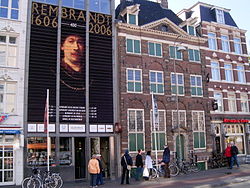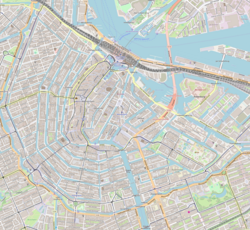Museum Het Rembrandthuis | |
 Rembrandt House Museum in 2006 | |
| Established | 10 June 1911[1] |
|---|---|
| Location | Jodenbreestraat 4[2] Amsterdam, Netherlands |
| Coordinates | 52°22′9.85″N 4°54′4.63″E / 52.3694028°N 4.9012861°E |
| Type | Biographical museum |
| Collections | Pre-Rembrandtists[3] Rembrandt's etchings[4] |
| Visitors | 226,304 (2023)[5] |
| Director | Milou Halbesma |
| Curator | Epco Runia, David de Witt, Leonore van Sloten, Nathalie Maciesza |
| Public transit access | Waterlooplein/Nieuwmarkt Tram: 9 Metro: 51 |
| Website | www |
The Rembrandt House Museum (Dutch: Museum Het Rembrandthuis) is a museum located in a former house in the Jodenbreestraat, in the center of Amsterdam. Between 1639 and 1658, the house was occupied by the Dutch painter Rembrandt van Rijn, who also had his studio and art dealership there.
The house was built around 1606 and was renovated around 1627, probably under the supervision of Jacob van Campen. It was then given an extra floor and a new facade with a triangular pediment. Rembrandt bought it on 5 January 1639 for thirteen thousand guilders. After his bankruptcy it was auctioned in 1658 and sold for eleven thousand guilders. In the following centuries it was used as a residence and was renovated several times.
At the beginning of the 20th century, the building was in poor condition, and on the occasion of the Rembrandt Year in 1906, it was purchased in 1907 by the municipality of Amsterdam, which donated it to the Rembrandthuis foundation. Between 1907 and 1911 the house was restored by Karel de Bazel. The museum was opened on 10 June 1911. Queen Wilhelmina and Prince Hendrik were the first visitors. The Rembrandt House Museum owes its foundation to an initiative by the painter Jozef Israëls.
Since 2008, the museum had around 200,000 visitors per year, with a record number of over 280.000 visitors in 2019.
- ^ Collection history, Rembrandt House Museum. Retrieved 19 August 2013.
- ^ Contact, Rembrandt House Museum. Retrieved 19 August 2013.
- ^ Paintings, Rembrandt House Museum. Retrieved 19 August 2013.
- ^ Rembrandt's etchings, Rembrandt House Museum. Retrieved 19 August 2013.
- ^ "Jaarverslag 2023 (Dutch)" (PDF). rembrandthuis.nl. Museum Rembrandthuis. Retrieved 4 September 2024.
